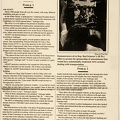The New York Times Sunday March 18, 1990
Growth of a Civil Rights Movement
The Disabled Find a Voice and Make Sure It Is Heard
by Steven A. Holmes
Doing whatever it takes to fulfill the promise of a landmark Federal law.
WASHINGTON
THE pictures were striking, just as they were intended to be: Children paralyzed from the waist down crawling up the steps of the Capitol, and more than 100 protesters, most in wheelchairs, being arrested by police officers in riot gear after a raucous demonstration in the Rotunda.
The aim of the demonstration was to press for enactment of the Americans with Disabilities Act, a comprehensive civil rights bill that extends to physically and mentally disabled individuals the same protections against biased treatment in employment, transportation and public accommodations now accorded women and minorities.
You can view disability rights as one of the latest chapters in the overall civil rights movement,” said Wayne Sailor, a professor of special education at San Francisco State University.
It was not always so. For years, the agenda for the disabled was set by organizations like the March of Dimes and the Easter Seals Foundation, which focused on providing services for the disabled and prying money loose from government and individuals to find cures for such illnesses as cerebral palsy.
In the last two decades, however, the attitude of those with disabilities has shifted from being passive recipients of institutional largess and paternalism to demanding a full role in society. “We're not Tiny Tims, or Jerry’s kids," said Bob Kafka, a quadriplegic from Austin, Tex., as he demonstrated outside the White House last week.
The disability rights movement was shaped by' a number of scientific, cultural and political forces. In many ways, it is a by-product of the technological revolution. Breakthroughs in medicine, the development of computers that allow the hearing and speech impaired to use telephones, and advancements in motorized wheelchairs have meant more people with severe handicaps live longer, can do more for themselves and have the potential for enjoying fuller lives.
"There are people with serious spinal cord injuries who used to die within two weeks that now live 30 or 40 years," said Dr. Frank Bowe, a deaf scholar whose 1978 book “Handicapping America" is to the disability rights movement what Betty Friedan's “The Feminist Mystique" was to the women's movement. “It’s one thing to say we have this marvelous technology, but if nobody‘s going to hire you, what's the point?”
As the most efficient means of creating disabled people, wars have always been a factor in advancing the disability rights movement, and Vietnam was a main force. The war added a large number of disabled veterans, already angry over America's indifference to their sacrifice in Southeast Asia, to an army of people with disabilities demanding fairer treatment. The Library of Congress, for example, estimates there are 43 million Americans with some form of disability.
In l973, after two vetoes by President Richard M. Nixon, Congress passed Section 504 of the Rehabilitation Act, which barred discrimination against the disabled by any entity receiving Federal funds. But no regulations were written to put it into effect until 1978, after advocates staged a 28-day sit-in.
Entrenched Barriers
But barriers remained entrenched in the private sector, where the bulk of the new jobs were created in the last decade. "We had no rights at all there," Dr. Bowe said.
During the l980's, the disability rights movement struck an alliance with traditional civil rights and feminist groups. As a result, for the first time, discrimination against the disabled was barred in the sale or rental of housing, “Standing alone, we could not have done that," said Pat Wright, director of the Disability Rights Education and Defense Fund, who is legally blind. “But wrapped in the arms of the civil rights community we had a lot more power."
The movement has also gained sympathetic ears both on Capitol Hill and in the Bush Administration. Officials and lawmakers who have relatives with various afflictions are more responsive, as are politicians who are increasingly aware that the votes of the disabled are up for grabs.
That point became clear after the Republican National Convention in 1988, when, in his acceptance speech, Mr. Bush became the first Presidential candidate to address the problems of the disabled directly. A poll by Louis Harris and Associates taken after Mr. Bush's speech showed that the lead Michael S. Dukakis held over Mr. Bush among disabled voters fell to 10 points, from 33.
But advocates say they have just begun. Just as the Government can pass laws that end racial discrimination, but not racism, it can outlaw biased treatment of the disabled but mot mandate acceptance of them.
“You can't legislate attitudes," said Ms. Wright. “But the attitudinal barriers will drop the more disabled people are employed, the more they can be seen on the street and when we become not just a silent minority, but full participating members of society.
Photo (from Associated Press): Looking up from the ground toward the dome of the Capitol in the background. In front a person in a wheelchair, back to the camera, holds the ADAPT flag. In front of the flag a man, Walter Hart, in a wheelchair with a bandanna tied around his head and dark sunglasses looks toward the first person. On the right side of the photo another man in a wheelchair, Joe Carle, sits talking with the other two.
Caption: Rally near the Capitol last week to press for a bill extending rights for the disabled.
- Created on
- Friday 12 July 2013
- Posted on
- Monday 29 June 2015
- Tags
- 504, ADA, Bob Kafka, civil rights, disability, DREDF - Disability Rights Education and Defense Fund, Frank Bowe, Pat Wright, President George HW Bush
- Albums
- Visits
- 3714
- Rating score
- 4.81 (1 rate)
- Rate this photo


0 comments